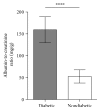Global Autorecognition and Activation of Complement by Mannan-Binding Lectin in a Mouse Model of Type 1 Diabetes
- PMID: 28751823
- PMCID: PMC5485322
- DOI: 10.1155/2017/9403754
Global Autorecognition and Activation of Complement by Mannan-Binding Lectin in a Mouse Model of Type 1 Diabetes
Abstract
Increasing evidence links mannan-binding lectin (MBL) to late vascular complications of diabetes. MBL is a complement-activating pattern recognition molecule of the innate immune system that can mediate an inflammation response through activation of the lectin pathway. In two recent animal studies, we have shown that autoreactivity of MBL is increased in the kidney in diabetic nephropathy. We hypothesize that long-term exposure to uncontrolled high blood glucose in diabetes may mediate formation of neoepitopes in several tissues and that MBL is able to recognize these structures and thus activate the lectin pathway. To test this hypothesis, we induced diabetes by injection of low-dose streptozotocin in MBL double-knockout (MBL/DKO) mice. Development of diabetes was followed by measurements of blood glucose and urine albumin-to-creatinine ratio. Fluorophore-labelled recombinant MBL was injected intravenously in diabetic and nondiabetic mice followed by ex vivo imaging of several organs. We observed that MBL accumulated in the heart, liver, brain, lung, pancreas, and intestines of diabetic mice. We furthermore detected increased systemic complement activation after administration of MBL, thus indicating MBL-mediated systemic complement activation in these animals. These new findings indicate a global role of MBL during late diabetes-mediated vascular complications in various tissues.
Figures






References
-
- WHO. Global Status Report on Noncommunacable Diseases 2014. World Health Organization; 2015. http://www.who.int/nmh/publications/ncd-status-report-2014/en/
-
- Jakuš V., Rietbrock N. Advanced glycation end-products and the progress of diabetic vascular complications. Physiological Research. 2004;53(2):131–142. - PubMed
MeSH terms
Substances
LinkOut - more resources
Full Text Sources
Other Literature Sources
Medical
Miscellaneous

